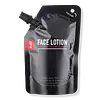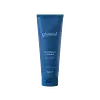What's inside
What's inside
 Key Ingredients
Key Ingredients

 Benefits
Benefits

 Concerns
Concerns

 Ingredients Side-by-side
Ingredients Side-by-side

Water
Skin ConditioningIsododecane
EmollientCaprylic/Capric Triglyceride
MaskingGlycerin
HumectantAloe Barbadensis Leaf Juice
Skin ConditioningCetyl Alcohol
EmollientPentylene Glycol
Skin ConditioningCetearyl Alcohol
EmollientDimethicone
EmollientSodium Hyaluronate
HumectantAllantoin
Skin ConditioningGlyceryl Stearate
EmollientPEG-100 Stearate
Ceteareth-20
CleansingCoco-Caprylate/Caprate
EmollientAnhydroxylitol
HumectantXylitol
HumectantXylitylglucoside
HumectantPanax Ginseng Extract
AntioxidantCamellia Sinensis Leaf Extract
AntimicrobialSymphytum Officinale Rhizome/Root Extract
Skin ConditioningCucumis Sativus Fruit Extract
EmollientAnthemis Nobilis Flower Extract
MaskingButyrospermum Parkii Butter
Skin ConditioningBrassica Campestris Seed Oil
Skin ConditioningLinum Usitatissimum Seed Oil
PerfumingTocopherol
AntioxidantRetinyl Palmitate
Skin ConditioningAscorbic Acid
AntioxidantXanthan Gum
EmulsifyingCarbomer
Emulsion StabilisingPhenoxyethanol
PreservativeEthylhexylglycerin
Skin ConditioningSodium Hydroxide
BufferingWater, Isododecane, Caprylic/Capric Triglyceride, Glycerin, Aloe Barbadensis Leaf Juice, Cetyl Alcohol, Pentylene Glycol, Cetearyl Alcohol, Dimethicone, Sodium Hyaluronate, Allantoin, Glyceryl Stearate, PEG-100 Stearate, Ceteareth-20, Coco-Caprylate/Caprate, Anhydroxylitol, Xylitol, Xylitylglucoside, Panax Ginseng Extract, Camellia Sinensis Leaf Extract, Symphytum Officinale Rhizome/Root Extract, Cucumis Sativus Fruit Extract, Anthemis Nobilis Flower Extract, Butyrospermum Parkii Butter, Brassica Campestris Seed Oil, Linum Usitatissimum Seed Oil, Tocopherol, Retinyl Palmitate, Ascorbic Acid, Xanthan Gum, Carbomer, Phenoxyethanol, Ethylhexylglycerin, Sodium Hydroxide
Water
Skin ConditioningGlycerin
HumectantIsostearyl Stearoyl Stearate
EmollientIsodecyl Neopentanoate
EmollientCetearyl Alcohol
EmollientMagnesium Ascorbyl Phosphate
AntioxidantDimethicone
EmollientGlyceryl Stearate
EmollientPEG-100 Stearate
C12-15 Alkyl Benzoate
AntimicrobialSqualane
EmollientPhenoxyethanol
PreservativePanthenol
Skin ConditioningAllantoin
Skin ConditioningTocopheryl Acetate
AntioxidantEthylhexylglycerin
Skin ConditioningRetinyl Palmitate
Skin ConditioningAscorbic Acid
AntioxidantSodium Hyaluronate
HumectantAloe Barbadensis Leaf Juice
Skin ConditioningVitis Vinifera Seed Extract
AntimicrobialAlchemilla Vulgaris Extract
AstringentRna
Skin ConditioningSuperoxide Dismutase
AntioxidantSodium PCA
HumectantYeast Beta-Glucan
Skin ConditioningCitrus Grandis Peel Oil
MaskingPrunus Amygdalus Amara Kernel Oil
MaskingTetrasodium EDTA
Water, Glycerin, Isostearyl Stearoyl Stearate, Isodecyl Neopentanoate, Cetearyl Alcohol, Magnesium Ascorbyl Phosphate, Dimethicone, Glyceryl Stearate, PEG-100 Stearate, C12-15 Alkyl Benzoate, Squalane, Phenoxyethanol, Panthenol, Allantoin, Tocopheryl Acetate, Ethylhexylglycerin, Retinyl Palmitate, Ascorbic Acid, Sodium Hyaluronate, Aloe Barbadensis Leaf Juice, Vitis Vinifera Seed Extract, Alchemilla Vulgaris Extract, Rna, Superoxide Dismutase, Sodium PCA, Yeast Beta-Glucan, Citrus Grandis Peel Oil, Prunus Amygdalus Amara Kernel Oil, Tetrasodium EDTA
Ingredients Explained
These ingredients are found in both products.
Ingredients higher up in an ingredient list are typically present in a larger amount.
Allantoin is a soothing ingredient known for its protective and moisturizingg properties. Because of this, it is often added to products with strong active ingredients.
Studies show higher concentrations of this ingredient can promote wound healing.
Though it can be derived from the comfrey plant, allantoin is produced synthetically for cosmetic products to ensure purity.
Learn more about AllantoinAloe Barbadensis Leaf Juice comes from leaves of the aloe plant. Aloe Barbadensis Leaf Juice is best known for helping to soothe sunburns. It is also anti-inflammatory, moisturizing, antiseptic, and can help heal wounds.
Aloe is packed with good stuff including Vitamins A, C, and E. These vitamins are antioxidants, which help fight free-radicals and the damage they may cause. Free-radicals are molecules that may damage your skin cells, such as pollution.
Aloe Barbadensis Leaf Juice also contains sugars. These sugars come in the form of monosaccharides and polysaccharides, folic acid, and choline. These sugars are able to help bind moisture to skin.
It also contains minerals such as calcium, 12 anthraquinones, fatty acids, amino acids, and Vitamin B12.
Learn more about Aloe Barbadensis Leaf JuiceAscorbic Acid is is pure Vitamin C. This form makes up the largest amount of vitamin C found naturally in our skin.
Not only is vitamin C great for your overall health and immune system, it also has plenty of benefits on your skin.
Vitamin C is best used for brightening skin. It improves dark spots, acne scars, and hyperpigmentation. This is because it blocks the process of skin darkening when exposed to UV.
Remember: Vitamin C should not replace sunscreen!
Your skin uses vitamin C to build collagen. Collagen is one key component in having a strong skin barrier and plump skin. Vitamin C also plays a role in regulating collagen, thus making it effective in improving wrinkles and fine lines.
Ascorbic acid shows potent antioxidant activity. As an antioxidant, it helps fight free-radicals. Free-radicals are molecules that may damage your skin cells. These antioxidants also protect skin against UV damage.
The best formulations include Vitamin E and/or ferulic acid. These two ingredients help stabilize and provide a boost in the benefits of ascorbic acid. This is because ascorbic acid becomes unstable when exposed to UV and air. In fact, you can tell your ascorbic acid has oxidized when it turns an orange-yellow color.
Ascorbic acid is generally compatible with other ingredients. However, using ascorbic acid with other active ingredients might cause irritation. Two ingredients: copper ions and benzoyl peroxide, will inactivate ascorbic acid completely.
Read more about other types of Vitamin C:
Foods rich with vitamin C include oranges, strawberries, broccoli, bell peppers, and more. When consuming Vitamin C, your skin receives a portion of the nutrients.
Learn more about Ascorbic AcidCetearyl alcohol is a mixture of two fatty alcohols: cetyl alcohol and stearyl alcohol. It is mainly used as an emulsifier. Emulsifiers help prevent the separation of oils and products. Due to its composition, it can also be used to thicken a product or help create foam.
Cetearyl alcohol is an emollient. Emollients help soothe and hydrate the skin by trapping moisture.
Studies show Cetearyl alcohol is non-toxic and non-irritating. The FDA allows products labeled "alcohol-free" to have fatty alcohols.
This ingredient is usually derived from plant oils such as palm, vegetable, or coconut oils. There is debate on whether this ingredient will cause acne.
Due to the fatty acid base, this ingredient may not be Malassezia folliculitis safe.
Learn more about Cetearyl AlcoholDimethicone is a type of synthetic silicone created from natural materials such as quartz.
What it does:
Dimethicone comes in different viscosities:
Depending on the viscosity, dimethicone has different properties.
Ingredients lists don't always show which type is used, so we recommend reaching out to the brand if you have questions about the viscosity.
This ingredient is unlikely to cause irritation because it does not get absorbed into skin. However, people with silicone allergies should be careful about using this ingredient.
Note: Dimethicone may contribute to pilling. This is because it is not oil or water soluble, so pilling may occur when layered with products. When mixed with heavy oils in a formula, the outcome is also quite greasy.
Learn more about DimethiconeEthylhexylglycerin (we can't pronounce this either) is commonly used as a preservative and skin softener. It is derived from glyceryl.
You might see Ethylhexylglycerin often paired with other preservatives such as phenoxyethanol. Ethylhexylglycerin has been found to increase the effectiveness of these other preservatives.
Glycerin is already naturally found in your skin. It helps moisturize and protect your skin.
A study from 2016 found glycerin to be more effective as a humectant than AHAs and hyaluronic acid.
As a humectant, it helps the skin stay hydrated by pulling moisture to your skin. The low molecular weight of glycerin allows it to pull moisture into the deeper layers of your skin.
Hydrated skin improves your skin barrier; Your skin barrier helps protect against irritants and bacteria.
Glycerin has also been found to have antimicrobial and antiviral properties. Due to these properties, glycerin is often used in wound and burn treatments.
In cosmetics, glycerin is usually derived from plants such as soybean or palm. However, it can also be sourced from animals, such as tallow or animal fat.
This ingredient is organic, colorless, odorless, and non-toxic.
Glycerin is the name for this ingredient in American English. British English uses Glycerol/Glycerine.
Learn more about GlycerinGlyceryl Stearate is a mix of glycerin and stearic acid.
It is used to stabilize the mixing of water and oil ingredients. By preventing these ingredients from separating, it can help elongate shelf life. It can also help thicken the product's texture.
As an emollient, it helps soften skin and supports barrier-replenishing ingredients.
In cosmetics, Glyceryl Stearate is often made from vegetable oils or synthetically produced.
This ingredient may not be fungal-acne safe
Fun fact: The human body also creates Glyceryl Stearate naturally.
Learn more about Glyceryl StearatePeg-100 Stearate is an emollient and emulsifier. As an emollient, it helps keep skin soft by trapping moisture in. On the other hand, emulsifiers help prevent oil and water from separating in a product.
PEGS are a hydrophilic polyether compound . There are 100 ethylene oxide monomers in Peg-100 Stearate. Peg-100 Stearate is polyethylene glycol ester of stearic acid.
Phenoxyethanol is a preservative that has germicide, antimicrobial, and aromatic properties. Studies show that phenoxyethanol can prevent microbial growth. By itself, it has a scent that is similar to that of a rose.
It's often used in formulations along with Caprylyl Glycol to preserve the shelf life of products.
Retinyl palmitate is a form of retinoid. Retinoids are the superstar class of anti-aging ingredients that include tretinoin and retinol.
This particular ingredient has had a bumpy year with its rise and fall in popularity.
First, Retinyl palmitate is created from palmitic acid and retinol. It is a retinol ester and considered one of the weaker forms of retinoid.
This is because all retinoids have to be converted to Tretinoin, AKA retinoic acid. Retinyl Palmitate is pretty far down the line and has to go through multiple conversions before its effects are seen.
Due to this long and ineffective conversion line, the benefits of Retinyl Palmitate are debated.
Studies show Retinyl Palmitate to help:
Dermatologists say this ingredient is ineffective because it isn't used in high enough concentrations in cosmetics.
This ingredient used to be found in sunscreens to boost the efficacy of sunscreen filters.
The downfall of Retinyl Palmitate was due to released reports about the ingredient being correlated to sun damage and skin tumors.
While there is a study showing this ingredient to cause DNA damage when exposed to UV-A, there is no concrete proof of it being linked to skin cancer. It is safe to use when used correctly.
All retinoids increase your skin's sensitivity to the sun in the first few months of usage. Be especially careful with reapplying sunscreen when using any form of retinoid.
Currently, this ingredient is still allowed in cosmetics all over the world. In Canada, cosmetics must have a warning label stating the product to contain Retinyl Palmitate
Fun fact: This ingredient is often added to low-fat milk to increase the levels of Vitamin A.
Learn more about Retinyl PalmitateSodium Hyaluronate is hyaluronic acid's salt form. It is commonly derived from the sodium salt of hyaluronic acid.
Like hyaluronic acid, it is great at holding water and acts as a humectant. This makes it a great skin hydrating ingredient.
Sodium Hyaluronate is naturally occurring in our bodies and is mostly found in eye fluid and joints.
These are some other common types of Hyaluronic Acid:
Learn more about Sodium HyaluronateWater. It's the most common cosmetic ingredient of all. You'll usually see it at the top of ingredient lists, meaning that it makes up the largest part of the product.
So why is it so popular? Water most often acts as a solvent - this means that it helps dissolve other ingredients into the formulation.
You'll also recognize water as that liquid we all need to stay alive. If you see this, drink a glass of water. Stay hydrated!
Learn more about Water